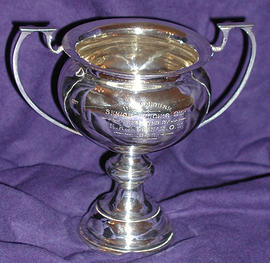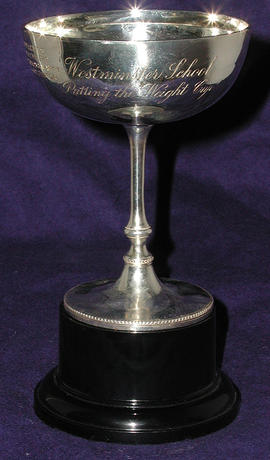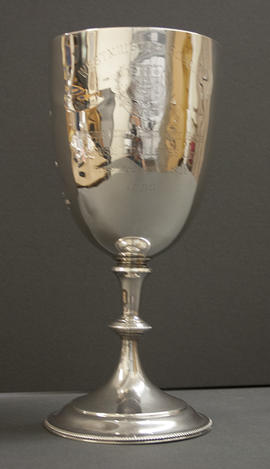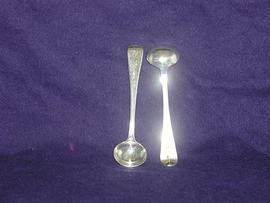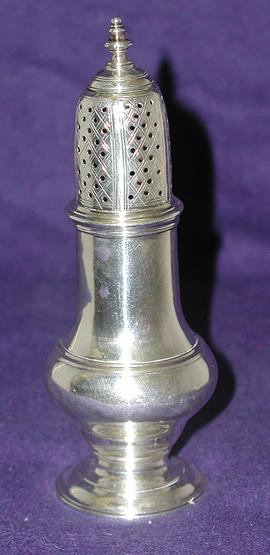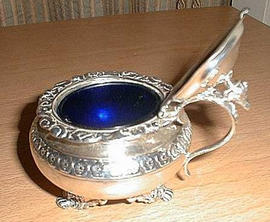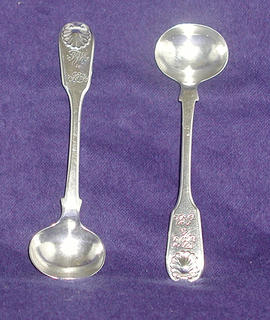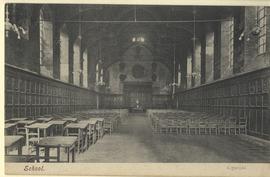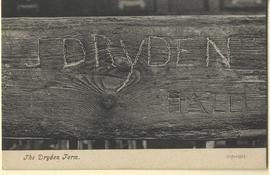Inscription: 'Interhouse Senior Fencing Cup presented by E.R.B. Graham O.W. 1946'. Not loaded. No cover. Black plastic plinth. Handles. Donor: E.R.B. Graham, 1946. Awarded: 1946-47-1967-68. Maker's mark obscured.
Inscription: 'Westminster School Putting the Weight Cup'. Not loaded. No cover. Black plastic plinth. Awarded: 1932-1974
Sem títuloJunior Long Distance Race House Challenge Cup. Not loaded. No cover. Donor: D.S.B, [Denny Brock] 1952. Awarded: 1952-1973. Numerous dents.
Sem títuloInscription: 'Governement de la Republique Francaise Westminster School Grand Concours 1952'. Not loaded. No cover. Handles.
Sem títuloPair of silver spoons engraved with an F. paired with mustard pots [T0001.065]
Sem títuloPepper caster [identical to T0001.067 but different date & maker]. Maker's mark obscured, probably SW.
A George III silver mustard pot on three feet, embossed with a border of flowers on foliate and paw feet, blue glass liner. Maker's mark obscured.
Pair of silver spoons engraved at tip. Paired with [T0001.073]. DR with crown. Makers Mark reads M M M.
One copy annotated on reverse as follows, by R.S. Chalk:
'Memories 1918-24 R.S.C
School- one of the three great losses in the Blitz.
Vastly impressive, tho’ by comparison with its present day counterpart, sombre, dusty and dark. (Yet HCW once lamented the Victorian ‘vandalism’ which enlarged all the medieval windows save one!)
Used for Assembly, lectures, Orations, Concerts, O.T.C. Parades (if wet), Physical Drill (‘Phys Hell’), Exams (as in this picture) and, above all, Latin Prayers.
Latin Prayers each day were a real joy- I never once heard criticism. All joined in singing in Elizabethan Latin. (I remember once (about 1920) three Arab Sheikhs attended these Prayers, and much impressed). The Masters knelt in the middle gangway on ‘pancake’ kneelers thrown (sic) out to them.
In the top foreground (then as now) may be seen the Pancake Bar. I was present in my second Term (Lent 1919) at the most famous Greaze of all- witnessed by King George V, Queen Mary, Prince of Wales and Prince Albert- won by D.L Moonan, K.S'
One copy annotated on reverse by R.S. Chalk, as follows:
'The ‘Dryden Form’ was kept unobtrusively somewhere behind the semicircle of seats for the Monitorial Council at the N. end of School. Few saw it there, and few cared.
It was first pointed out to my father and myself by E.L. Fox when I appeared for my first Challenge in 1918.
No doubt (likes so much else stored Up School) it perished for ever in the Blitz.
The Form itself was exceedingly rough, worn by the seats of generations.
In the dim light of School the letters could barely be made out (It may be noticed John Brown has traced them round in chalk for this photograph). To my mind it is open to question whether they were carved by the Poet or by his son of the same name (K.S. 1682-5). Nearby was cut in huge, deep letters ‘A.SLADE’. We all knew the tradition that it had cost him 500 lines for each letter (see L.E. Tanner, p32)'
